Hardwood Clocks are in the works here at the Bungalow and I’m here to give you a behind the scenes tour of their construction.
At first I made templates for the clocks out of cereal boxes. I figured I could mix and match angles, colors, and the like to make pleasing compositions. I took out my compass (hand drafting isn’t dead yet) and cut out 40 or so different angle templates. Then I mixed and matched until the angles added up to 360 degrees (see below).

Now I could be assured my cut pieces of wood would form a perfect 360 circle. All I had to do was transfer the exact angles to select pieces of wood and cut those angles exactly with no margin for error.
Laying out the templates on the wood went well, after that things sort of fell apart. I selected five different woods for the first clock (from top to bottom in the picture) – cherry, hickory, walnut, red oak, and poplar.
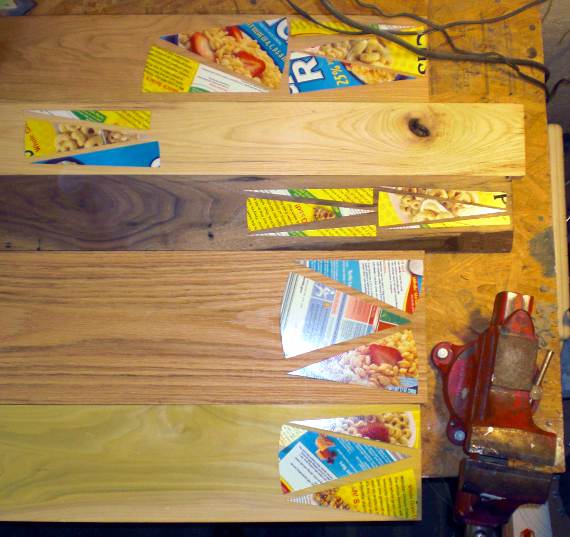
I transferred the angles to the wood with a pencil, cut the pieces to length on the miter saw then turned to the tablesaw. Here is where my grand plan began to unravel. Just how do I cut those angles with no margin for error? I looked around for a laser wielding robot, but I don’t have any in the shop. The best I could come up with was to fall back on high school geometry.
I cut small pieces on the tablesaw with a sled that slides on the top (and keeps my fingers far away from the blade) – see below.
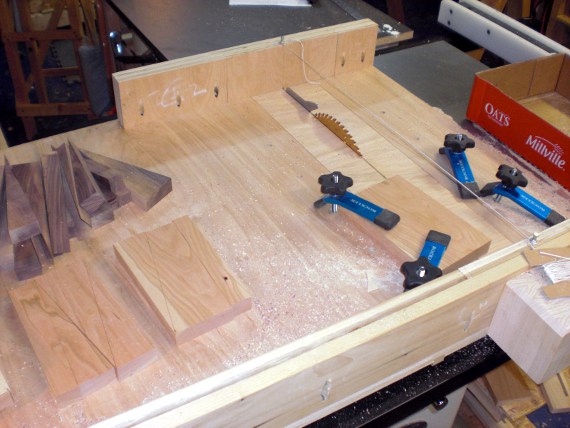
The sawblade leaves a cut line the exact width of the blade (handy) – this forms one side of a plane. Directly above this line I attached a string that I could site the angle of the cut – forming the second side of a plane. Line up the sawblade, the pencil mark on the wood, and the string – and the wood will be cut exactly. Assuming the pencil line intersects the blade/string plane exactly. You can see this in the picture better.
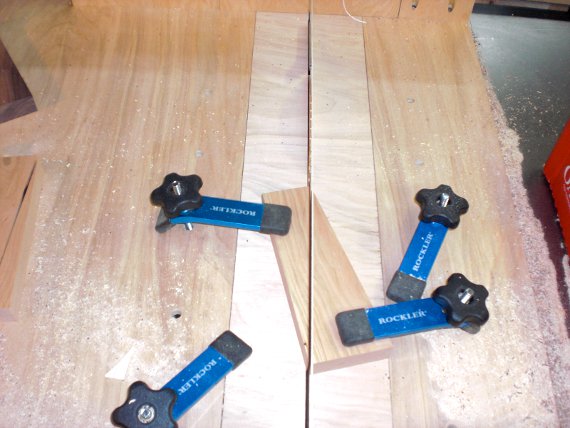
Of course no matter how “well” I eyeballed it, the angles couldn’t be cut exactly so I ditched that plan and just cut a load of different angles, figuring if I had enough angles I could put together a circle later. You can see the blue clamps in the picture above – super handy for holding the wood in place securely and keeping me as safe as possible.
Below you can see stacks of the cut wood. On the top are pieces of walnut. The lower left is hickory and the lower right is cherry. With the cherry you can see how I make the cuts – rotating the wood to keep the grain in as radiating a pattern as possible. In the next post I’ll talk about layout and glue-up of the clocks.
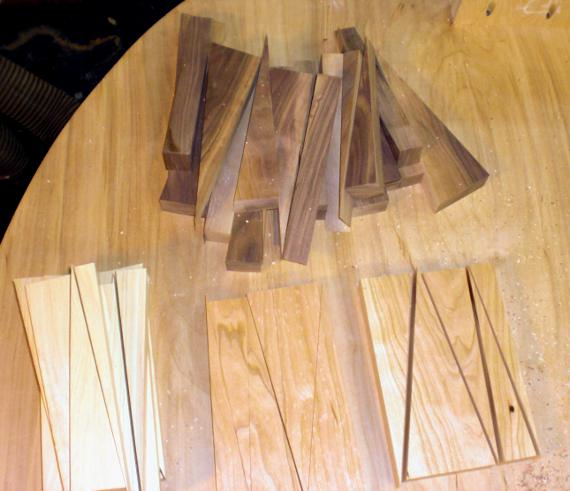
Read the next post in the series here
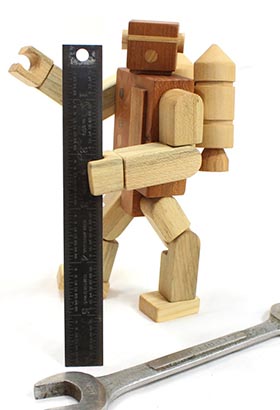

Wee Folk Fairy Fest – Post Show
/in Kid Approved, Shows /by DonI’ve been taking lots of new product pictures and working on the etsy shop these past few days, but I wanted to recap the latest show before it’s too far from my memory. A lot has changed since my first show a little more than a month ago. The booth display looks much better and there’s more neat product on display.
I had the time to finish the tables with tung oil which really helps them pop. I shifted the alignment of the tables as well, and more densely packed items. I also have the super nifty tree display.
Gone is the red paper with handwritten prices. Also gone are the painted clocks. Not making a second appearance was the train set on the ground. There’s a whole separate blog post (or three) about that thing.
The animals were the biggest seller from the last show and they were again this show. I moved them to the center table to give them more visibility. Once again people like the dollhouse bookends – who wouldn’t? They’re so darn cute. The new hardwood clocks got quite a few nods as well. I appreciate all the kind comments given.
The show itself had a lot of activities for the family – a petting zoo, music, belly dancers, singers and dancers, and a parade. My kids had to leave before the parade, but had a great time before they left.
Wee Folk Fairy Festival
/in Shows /by DonSaturday October 1st. Happy Bungalow will be showing off a month’s worth of new product making.
Click on SHOWS above or hereHummingbirds, butterflies, flowers, and more. Fill a vase with flowers that never die, or bring a flower sculpture to work to liven up your home.
I’ll also have the new hardwood clocks you’ve read so much about, some cool new paintings, and some spiffy new animals.
[edit: Many years later we choose to leave this post as is. It’s sort of an honest time capsule. This reads more like a social media post than what we try to write on the blog now. But hey, it’s a learning process.]
New Hardwood Clocks Are For Sale
/in For Your Home /by DonYou’ve read all the whole behind the scenes series about the hardwood clocks, now find them for sale in Happy Bungalow’s etsy shop.
Wood Clocks Process #4 – Finished Product
/in Process, Prototype /by DonMissed the creation of the clocks? Read part one, part two, and part three.
Hooray! The hardwood clocks are finished (get it? finished?), their dials have been painted, the movements installed, and the hangers hung. Shown below is a strip clock (I’m open to catchier names) and the oh-so-cleverly named five grain clock (five different types of wood). None of the wood was stained – the colors you see are natural.
A closer look at the five grain clock. The darkest wood is walnut and the lightest is hickory. The greenish wood is poplar. The reddish wood with the wavier grain is cherry, and the reddish wood with the tighter grain is red oak. The dials are metal and hand painted with yellow enamel paint.
The strip clock only has three woods. The dark is walnut and the lightest is hickory. Cherry is the friendly red. Once again, the dials were hand painted yellow.
Below is the rear of the five grain clock. Each clock has three separate hangers so you can mix up the position of the clock. Of course after I attached the hangers I discovered you can’t willy-nilly put on the hangers – Twelve O’clock doesn’t coordinate with any position. After some dial spinning and head scratching I figured it out and repositioned two of the hangers. Oops (these clocks will have a discount in the etsy shop).
All of the woods are labeled on the back – no need to be a wood expert to impress your friends. “Yes, this is cherry, and that is hickory.” The clock crafted date and signature is listed as well.
http://happybungalow.com/blog/2011/09/22/wood-clocks-process-3/
Wood Clocks Process #3
/in For Your Home, Process, Prototype /by DonIn the previous post our wood clocks were dry-fitted and glued-up (read the post here). You may remember some dried up glue that leaked out of the joints. The glue was knocked away with a sander as were any wood segments that were higher than the others. Despite the best efforts of the heavy took box, some of the pieces moved up oh so slightly. Ideally I’d run the clocks through a planer (mine isn’t wide enough) or a wide belt sander (nobody has dropped one off at the shop). So I sand them down with a 1/3 sheet sander.
The next step is to trim up the clocks. I lay out the circle with my drafting compass (in the upper right in the picture below) and lay out a circle as big as the smallest wood segment. In short – I make the clock as big as I can. I trim the circles on the bandsaw, sand the edges smooth on a stationary belt sander, and bring them back to the table.
You can see how much sanding dulls the look of the wood. I plane all my wood in the shop (three giant knives spinning really fast and slicing away wood) – which leaves the wood ultra smooth. Sanding also smooths the wood, but instead of slicing the wood, the sanding compresses the grain of the wood, so it doesn’t look as crisp. But don’t worry, we’re going to fix that during the finishing.
There’s one last step before the finishing – cutting holes for the clock movement (the gizmo that turns the clock hands). I start with drilling a small hole through the center on the front. Then I drill a big hole in the back (I’m thinking the Bungalow’s resident hamster may find some use for them).
This part’s a little tricky – drill too far and the clock is ruined. Drill not far enough, and well – just drill some more. Fortunately my 3-1/8 inch drill bit isn’t very fast. Notice the clamps in the picture. The clock must be clamped to something secure as the large drill bit creates a lot of torque.
Now the fun part – finishing. I finish the clocks with pure tung oil – which penetrates the wood to protect it. Pure tung oil is a legitimate natural finish. The only thing in my tung oil? Tung oil. There’s no laundry list of additives and chemicals on the side of the jar. The only thing I add is citrus solvent which thins the oil to aid penetration into the wood.
Citrus solvent? It’s natural too – derived from oranges. And it smells great – the whole shop smells like oranges. The tung oil gives the wood a lot of pop and shows off the grain well.
Grain? The upper left clock has alternating segments of walnut and cherry. The lower clock has cherry, walnut, poplar, red oak, and hickory. The strip clock has hickory, walnut, and cherry.
Read the fourth and final post here
Wood Clocks Process #2
/in Process, Prototype /by DonIn part one of the wood clocks process series (read here) I talked about cutting a number of angled pieces of wood. A box-full of wood pieces, in fact. I lay all the pieces out on a table and go to work creating a pleasing composition. With some fussing, this process goes easy until the clock circle is about seven-eigths full. Then it’s time to trade out triangles here and there to make a 360 degree circle. To make certain of this, I tape the pieces securely together. Once I have a working circle I move some of the triangles around to fuss with the layout.
Next comes the glue. I lay down some wax paper on the table to keep the clock from gluing itself to the table. There’s between 25-35 pieces in each clock and each side needs glue applied evenly. I have to move quickly so the glue doesn’t set before I’m finished. You can see the glue squeezing out in the picture below – this is a good thing as it means the joints are filled.
Once all the glue is on and the pieces are in place I put a strap around everything – that’s the black band in the picture. I cinch the strap then insert blocks of wood around the perimeter. The blocks help to make up for the different lengths of wood and give added clamping pressure. Then I wipe all the excess glue away with a damp cloth.
Next comes another sheet of wax paper and some MDF spacers to clear the wood blocks on the perimeter. I pile on my heaviest tool box and anything else that’s heavy and handy. This weight keeps the pieces flush. You can see some glue squeezing out on the sides – but this isn’t a problem as the clock will be trimmed later.
The picture shows a wood-strip clock being glued up – more on that below.
The clock dries for a while before the weight is removed. You can see a little glue that leaked through, but it’s nothing a little sanding won’t clear up.
The picture below is one of the wood-strip clocks. It’s like the other clocks except it only has one angle, so there’s much less math involved. I lay out the strips, then cut each strip roughly to length so I don’t loose any more wood than necessary. On the left you can see a rejected angle piece and a buddy angle that I used to clamp everything together.
The strip clocks don’t need the belt clamp – just a pair of bar clamps (and the heavy weight on top). More on trimming, sanding, and finishing in the next post.
Read the next post in the series here
Wood Clocks Process #1
/in Process, Prototype /by DonHardwood Clocks are in the works here at the Bungalow and I’m here to give you a behind the scenes tour of their construction.
At first I made templates for the clocks out of cereal boxes. I figured I could mix and match angles, colors, and the like to make pleasing compositions. I took out my compass (hand drafting isn’t dead yet) and cut out 40 or so different angle templates. Then I mixed and matched until the angles added up to 360 degrees (see below).
Now I could be assured my cut pieces of wood would form a perfect 360 circle. All I had to do was transfer the exact angles to select pieces of wood and cut those angles exactly with no margin for error.
Laying out the templates on the wood went well, after that things sort of fell apart. I selected five different woods for the first clock (from top to bottom in the picture) – cherry, hickory, walnut, red oak, and poplar.
I transferred the angles to the wood with a pencil, cut the pieces to length on the miter saw then turned to the tablesaw. Here is where my grand plan began to unravel. Just how do I cut those angles with no margin for error? I looked around for a laser wielding robot, but I don’t have any in the shop. The best I could come up with was to fall back on high school geometry.
I cut small pieces on the tablesaw with a sled that slides on the top (and keeps my fingers far away from the blade) – see below.
The sawblade leaves a cut line the exact width of the blade (handy) – this forms one side of a plane. Directly above this line I attached a string that I could site the angle of the cut – forming the second side of a plane. Line up the sawblade, the pencil mark on the wood, and the string – and the wood will be cut exactly. Assuming the pencil line intersects the blade/string plane exactly. You can see this in the picture better.
Of course no matter how “well” I eyeballed it, the angles couldn’t be cut exactly so I ditched that plan and just cut a load of different angles, figuring if I had enough angles I could put together a circle later. You can see the blue clamps in the picture above – super handy for holding the wood in place securely and keeping me as safe as possible.
Below you can see stacks of the cut wood. On the top are pieces of walnut. The lower left is hickory and the lower right is cherry. With the cherry you can see how I make the cuts – rotating the wood to keep the grain in as radiating a pattern as possible. In the next post I’ll talk about layout and glue-up of the clocks.
Read the next post in the series here
New Blog
/in Business, Prototype /by DonI’ve been working for a few weeks (eek, has it been THAT long?) on a new WordPress blog for happybungalow.com. WordPress will give me more flexibility and capabilities than my previous blog software. BUT – I had to learn some new web programming and remember some other programming I had forgotten.
Now you can comment on the posts you see here. Go ahead, comment away.
I’ll have some new pictures and blogs up shortly. Some exciting stuff is in the pipeline.
See all of our completed products for sale at our etsy shop
New Stuff in the Works
/in Fun Stuff, Prototype /by DonThis week is new product week (and next week and probably the next). On the drawing board: chessboard, serving trays, nifty clocks, plywood graphic paintings, jewelry boxes, and whatever else shows itself. I’m putting together a mockup for a wood starburst clock (see picture below) – trying to figure out how to build the thing. There’s 30+ pieces that need to fit exactly, and while I could draw it to exact dimensions and angles, I don’t think those angles would translate to the finished piece. So I figure I’ll trial and error the operation until I figure out the best method.
Anyway – I liked the mockup – thinking it would look good on a wall by itself. So I’m going to take all the little pieces and transfer the angles to pieces of cherry and glue up with the walnut strips. Now I have to figure out how to glue all the little pieces together just so.
Yesterday I was working on some plywood graphic paintings. I’ve done a few before and like the way they turn out – I figure some other people might too. It’s delicate work and as long as I don’t think about it my hand doesn’t shake – but then it does and I have a little oops. My instant reaction? I look up at the top of the painting for the UNDO button. It’s not the first real life mistake that I’ve looked for a digital correction for.
Happy Bungalow’s First Arts and Crafts Show
/in Business, Kid Approved, Shows /by DonHappy Bungalow’s first arts and crafts show was this past Saturday. The show was around the corner and down the street from my house. This allowed the whole Happy Bungalow crew to attend (my wife, the kids, and I). There was a good crowd turnout and a there was a full array of vendors to buy from. Here’s how my booth looked:
Not only was it my first show, it was my first day selling to the public as well. I was super nervous and for the past few weeks I’ve been focused on little else than the show. Months ago I planned to buy folding tables, but a few weeks ago changed my mind. So I made four wood tables that I could take apart for easier transport. I also made a sign, stands for the clocks, and business card holders. I wasn’t happy with the greenish buckets at the corners, but they kept the awning from flying away (bonus). I thought I could make some (nice) plywood containers and fill them with sand or concrete. We’ll see.
At the finishing stage of the sign I had an accident and before I could do anything the accident dried. My wife couldn’t spot it, so maybe it’s not so bad. Along with the sign I put a sample of all the products on the table. Quite a few people stopped to look. Everyone loves the cute dollhouses and the animals. People liked the knobs too. The tables were unfinished (not enough time) so the rest of the unfinished wood products blended into the table. My wife had the idea to put paper on the table – sort of like butcher’s paper. This worked well as I wrote descriptions of the product and prices on the paper. I like the concept, but I’d like to find a different color paper.
You can get a closer look at the tables – the legs are planed lumber and the tops are birch veneered plywood. They’re lightweight and universally interchangeable. The animals were a big hit – especially the walnut animals. I’ll be making more of those soon. This is where Happy Bungalow’s first sale came from. Not a dollar, but a twenty – I’ll frame it anyway. A super sweet lady at the next booth came over to congratulate me. I made more sales later, handed out business cards, and talked to a lot of people. I can’t wait for the next show.